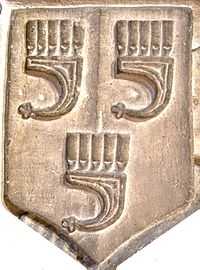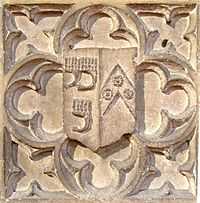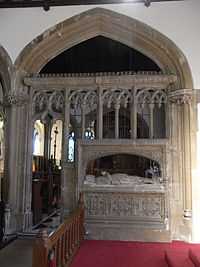Thomas Grenville (d.1513)
Bideford.jpg)
Sir Thomas Grenville (died 1513), KB, lord of the manors of Bideford in Devon and of Stowe in the parish of Kilkhampton in Cornwall, was Sheriff of Cornwall in 1481 and in 1486.[3] During the Wars of the Roses in his youth he had been a Lancastrian supporter and had taken part in the conspiracy against Richard III organised by the Duke of Buckingham.[4] On the accession of King Henry VII (1485–1509) and the end of the wars, Grenville was appointed one of the Esquires of the Body to Henry VII.[5] On the marriage of Prince Arthur to Katherine of Aragon on 14 November 1501 he was created a Knight of the Bath.[6] He served on the Commission of the Peace for Devon from 1510 to his death.[7]
Origins


He was the son and heir of Sir Thomas Grenville by his second wife Elizabeth Gorges, daughter of Theobald Gorges and sister of Sir Theobald Gorges.[8] Although little if anything at all survives in historical records concerning his biography, he was the descendant of a notable ancestor who took part in the Norman Conquest of Glamorgan, namely Sir Richard Grenville one of the Twelve Knights of Glamorgan who won for himself the Welsh lordship of Neath and in 1129 founded there Neath Abbey. Sir Thomas was himself ancestor to famous descendants, most notably his great-great-grandson Sir Richard Grenville (1542–1591), the valiant captain of "The Revenge" and of Sir Bevil Grenville (1596–1643), MP and famous Civil War commander, father of John Grenville, 1st Earl of Bath (1628–1701). He was also the ancestor of the Grenville Marquesses of Buckingham, title created in 1784, and the Grenville Dukes of Buckingham and Chandos, a title created in 1822.
Marriages

He married twice:[9]
- Firstly to Isabel Gilbert, daughter of Otes Gilbert of Compton Castle by his wife Elizabeth Hill, daughter of Robert Hill of Shilston.
- Secondly to the widow of a certain "Hill de Taunton"
Progeny by first marriage


By his first wife Isabel Gilbert he had issue two sons and six daughters:[10]
- Sir Roger Grenville (1477–1524), eldest son and heir, Sheriff of Cornwall in 1510–11, 1517–18, 1522, who was present within the Cornish contingent at the Field of the Cloth of Gold.[11] He married Margaret Whitlegh (or Whitely) the daughter and co-heiress of Richard Whitlegh (d.1509)[12] of Efford, about three miles from Stowe.[13] His sons (all of whom have left surviving letters in the Lisle Papers) were:[14]
- Sir Richard Grenville (c. 1495-1550), eldest son and heir. Entered the Inner Temple, with his brother John, in 1520;[15] MP for Cornwall in 1529.[16] He married Matilda Bevil, daughter and co-heiress of John Bevil of Gwarnock, St Allen, Cornwall. He was pre-deceased by his eldest son Roger Grenville (d.1545), captain of the Mary Rose when it sank in Portsmouth Harbour in 1545, whose son was the heroic Admiral Sir Richard Grenville (1542-1591), Captain of the Revenge, MP for Cornwall, Sheriff of Cork from 1569-70, Sheriff of Cornwall in 1576–77, Armed Merchant Fleet Owner, privateer, colonizer, and explorer.
- John Grenville (c. 1506 - c. 1562), 2nd son. Entered the Inner Temple, with his brother Richard, in 1520.[17] Thrice MP for Exeter, in 1545, 1554 and 1558.[18] In 1534 he purchased the reversion of the office of a Serjeant-at-Arms, which office he performed for King Henry VIII from 1535. He was a servant successively of Sir Thomas More and Lord Chancellor Thomas Audley. He married Lettice Lucas, daughter of Thomas Lucas of Suffolk.[19]
- Diggory Grenville, 3rd son, some of whose correspondence, in connection with his management of his aunt Honor Grenville's manor of Umberleigh, survives in the Lisle Papers.
- Richard Grenville, pre-deceased his father, unmarried.[20]
- Jane Grenville, married Sir John Arundel of Trerice in Cornwall
- Mary Grenville, married firstly Richard Bluett (1479 - c. 1523) of Holcombe Rogus in Devon and Cothay Manor, which he rebuilt, in Somerset. His monumental brass exists in St Nicholas' Church in Kittisford, Somerset; secondly to Thomas St Aubyn.
- Agnes Grenville, married John Roscarrock of Roscarrock near Port Isaac.[21]
- Philipa Grenville (d.1524), married firstly Francis Harris (1475–1509) of Radford; secondly Humphry Arundell of Lanherne, younger brother of Sir John Arundell (1474–1545), her brother-in-law.[22]
- Honor Grenville, married firstly Sir John Bassett (d.1529) of Umberleigh in Devon; secondly to Arthur Plantagenet, 1st Viscount Lisle. Much is known about her life from her surviving correspondence in the Lisle Letters.
- Katherine Grenville, youngest daughter, married in 1507 Sir John Arundell (1474–1545) of Lanherne, Receiver General of the Duchy of Cornwall and "the most important man in the county".[23]
Progeny by second marriage
By his second marriage Sir Thomas had two further children:[24]
- John Grenville, appointed by his father rector of Kilkhampton in 1524, in which office he remained until 1580.[25]
- Jane Grenville
Monument in Bideford

A monument with recumbent effigy on a chest tomb exists of Sir Thomas Grenville in the Church of St Mary, Bideford. Inscribed on the Tudor arch above is the following Latin text:
Hic jacet Thomas Graynfyld miles patron(us) (huius) eccle(siae) q(ui) obiit XVIII die me(n)sis Marcii A(nno) D(omini) MCCCCCXIII cui(us) a(n)i(ma)e p(ro)piciet(ur) D(eus) Amen ("Here lies Thomas Grenville, knight, patron of this church who died on the 18th day of March in the Year of Our Lord 1513, to whose soul may God look on with favour Amen")His recumbent effigy is shown fully armed in a suit of Almain rivets and his feet rest on a dog. His hair is of chin-length and his hands are clasped in prayer holding a ball shaped object, his heart according to Granville (1895).[26] His head is inclined slightly to the south, as if looking towards the altar of the Lady Chapel. He wears a double chain around his neck. There are several heraldic escutcheons on the monument displaying the arms of Grenville: Gules, three clarions or. The monument is an important early source for use in deciphering the form of these mysterious and unexplained charges.
The monument was described thus in 1895 by Roger Granville, Rector of Bideford and the family's historian:[27]
The monument is on the south side of the chancel, near the altar. It consists of a free stone table, upon which lies the figure of Sir Thomas arrayed in the armour of the time. The pauldrons and coudieries are ornamented, and the brassarts and vambraces puffed or ribbed. Taces,[28] to which are appended deep lambeaux of over-lapping plate, a large apron of chain mail, and broad-toed sabatons complete his costume, and he is armed with sword and misericorde. On his breast hangs a double chain. The head of the effigy is (in accordance with a practice adopted towards the close of the XV Century with armed figures) bare, but rests on a tilting helmet, out of which is issuant a small shield charged with the Granville arms. In his hand he holds his heart, an occurence also frequent with mediaeval figures. At his feet is a dog or rather two half-dogs, conjoined so cleverly that to a casual observer, standing on either side of the monument, there appears only one dog, the two heads being so carved as to serve equally well for hind-quarters. Over the figure is an arch with screen work, the top of which is muriated.
Residences
Bideford was the residence of the Grenville family from shortly after the Norman Conquest and Stowe in Cornwall was also a seat. Sit Thomas appears to have been one of the last of the family to reside chiefly at Bideford, if indeed the presence there of his effigy may be allowed to suggest that, and his descendants made Stowe their chief seat, whilst retaining ownership of Bideford until the family died out in the senior male line. The Grenville heraldic device of the three clarions are still borne by distant relatives, Baron Grenfell[29] and are borne in the 3rd quarter by Earl Granville.[30]
Further reading
- Granville, Roger, (Rector of Bideford), History of the Granville Family Traced Back to Rollo, First Duke of the Normans, With Pedigrees etc., Exeter, 1895, pp.58-70, re Sir Thomas Grenville
- Round, J. Horace, Family Origins and Other Studies, ed. Page, William, 1930, pp.130-165, Grenville Family (a critique of Roger Granville's 1895 work)
Sources
- Vivian, Lt.Col. J.L. & Drake, Henry H., (Eds.), The Visitation of the County of Cornwall in the Year 1620, London, 1874: Grenville pedigree pp. 84–87
- Byrne, Muriel St. Clare, (ed.) The Lisle Letters, 6 vols, University of Chicago Press, Chicago & London, 1981, esp. vol.1, pp.299-351, "Grenvilles and Bassets"
References
- ↑ Granville, Roger, History of the Granville Family, Exeter, 1895, pp.68-9
- ↑ Vivian, Visitation of Devon, 1895, p.405, Gilbert of Compton
- ↑ Richard Polwhele, The Civil and Military History of Cornwall, volume 1, London, 1806, pp 106–9; Byrne, vol.1, p.302 states "1485", quoting Public Record Office, Lists & Indexes, vol.IX, List of Sheriffs
- ↑ Byrne, vol.1, p.302
- ↑ Byrne, vol.1, p.302
- ↑ Byrne, vol.1, p.302
- ↑ Byrne, vol.1, p.302
- ↑ Vivian, 1874, p.84
- ↑ Vivian, 1874, p.84
- ↑ Vivian, 1874, p.84; Byrne, vol.1, p.302,307
- ↑ Byrne, vol.1, p.303
- ↑ Byrne, vol.1, p.307
- ↑ Byrne, vol.1, p.307
- ↑ Byrne, vol.1, p.303
- ↑ Byrne, vol. 4, p.11
- ↑ Goring, J.J., Biography of Richard Grenville (c. 1495-1550) published in History of Parliament: House of Commons 1509-1558, ed. S.T. Bindoff, 1982
- ↑ Byrne, vol. 4, p.11
- ↑ Hawkyard, A.D.K., Biography of John Grenville (c. 1506 - c. 1562) published in History of Parliament: House of Commons 1509-1558, ed. S.T. Bindoff, 1982
- ↑ Byrne, vol.1, p.474
- ↑ Byrne, Muriel St. Clare, (ed.) The Lisle Letters, 6 vols, University of Chicago Press, Chicago & London, 1981, vol.1, p.302
- ↑ Byrne, vol.1, p.307
- ↑ Byrne, vol.1, p.307
- ↑ Byrne, vol.1, p.307
- ↑ Byrne, vol.1, p.302
- ↑ Byrne, vol.1, p.302
- ↑ Granville, Roger, History of the Granville Family, Exeter, 1895, pp.68-9
- ↑ Granville, Roger, History of the Granville Family, Exeter, 1895, pp.68-9
- ↑ Taces: overlapping plates to envelope the abdomen; Below the waist were worn the taces or laminated strips of plate overlapping each other. In the early period of plate, they were attached to a leather lining. Later, they were held together by sliding rivets, which allowed a certain amount of vertical play.
- ↑ Debrett's Peerage, 1968, p.510
- ↑ Debrett's Peerage, 1968, p.505